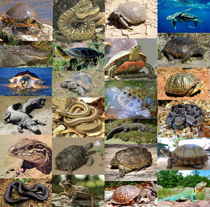Michigan State Reptile
Painted Turtle

(Chysemys picta)
Adopted in 1995.
Perhaps the most common of turtles, the painted turtle (Chysemys picta) owes its place among Michigan's state symbols to a group of Niles fifth-graders. After discovering that no reptile represented the state, the children approached their state representative and followed the legislative process to its enactment as Public Act 281 of 1995.
Turtles are among the longest living animals on earth. Several species of turtles can live for several decades. With this longevity also comes a negative side. It takes several years for turtles to sexually mature (4 to 10 years for a Painted turtle, 14 to 20 years for a Blanding's or Wood turtle, and 15 years for a Snapping turtle). Non breeding turtles are often the targets of predators, automobiles, and pet seekers. In addition, the longer life span allows turtles to build up environmental toxins in their tissues. These toxins can have serious affects on a turtle's health and breeding ability.
Michigan State Reptile: Painted Turtle

Painted turtles are brightly marked. They have a smooth shell about 90 to 250 mm long. Their shell acts as protection, but since the ribs are fused to the shell, the turtle cannot expand its chest to breathe but must force air in and out of the lungs by alternately contracting the flank and shoulder muscles. The painted turtle has a relatively flat upper shell with red and yellow markings on a black or greenish brown background. Males mature at about 70 to 95 mm plastron (lower shell) length, usually at 3 to 5 years of age. Females at take longer (6 to 10 years) and are larger at maturity (c. 100 to 130 mm plastron length). The growth rate, for both sexes is rapid during the first several years of the of their lives. Turtles continue to grow slowly after maturity, and this species may reach 250 mm carapace (upper shell) length and live for many decades.
Behavior
Painted turtles bask in large groups on logs, fallen trees, and other objects. The sunning helps rid them of parasitic leeches. In many areas turtles hibernate during the winter months by burrowing into the mud and allowing their bodies to become very cold. Because of their small body size, they can move easily. Turtles dive quickly at the first hint of danger. Painted turtles are diurnal; that means they are active during the day. At night they will rest on the bottom of a pond or on a partially submerged object, such as a rock. During the day, painted turtles will bask in the sun, sometimes as many as 50 on one log, stacked on top of each other.
Habitat
The turtles' environment includes a unique blend of niches from wetlands, to uplands, to sand sites. Each niche is important to satisfy the separate living, breeding, and feeding requirements of Michigan turtles
Reproduction
Mating begins after hibernation and before feeding begins when the water temperatures are still low. Fall mating may also occur. Temperature is a major environmental cue for the regulation of the seasonal gonadal cycle, but the thermal dependence of the reproductive system differs markedly for the two sexes.
Michigan Law
The law designating the painted turtle as the official Michigan state reptile is found in the Michigan Compiled Laws, Chapter 2, Section 2.14.
Michigan Public Act 281 of 1995.
STATE REPTILE (EXCERPT)
Act 281 of 1995
2.14 State reptile.
Sec. 1. The painted turtle (Chrysemys picta) is designated as the official reptile of this state.
History: 1995, Act 281, Imd. Eff. Jan. 9, 1996.
Taxonomic Hierarchy: Painted Turtle
Kingdom: Animalia
Phylum: Chordata
Subphylum: Vertebrata
Class: Reptilia
Order: Testudines
Family: Emydidae
Subfamily: Deirochelyinae
Genus: Chrysemys - Gray, 1844
Species: C. picta








